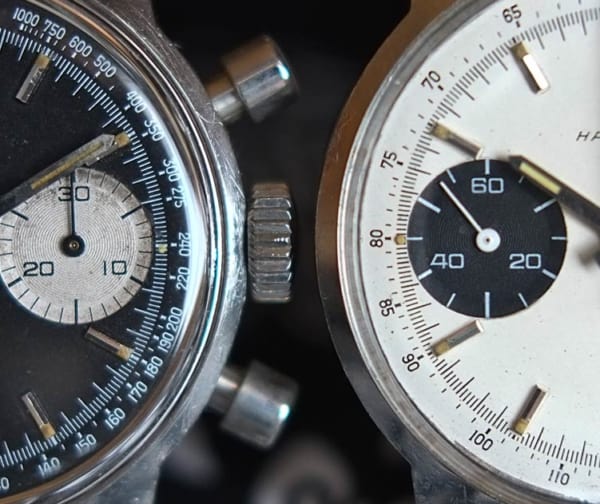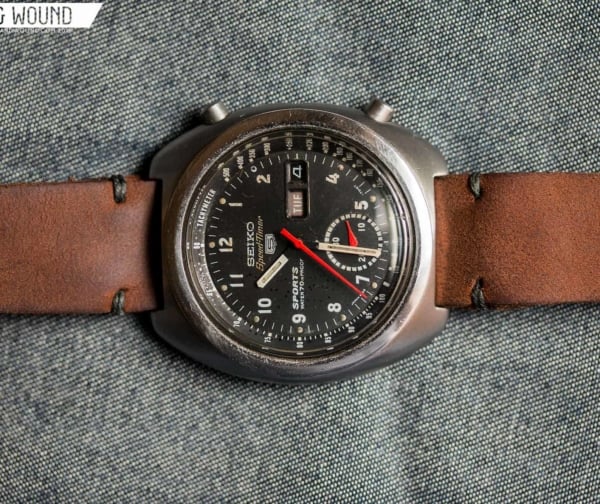If you’re the type to browse forums for vintage watches, chances are you’ve stumbled across Le Jour from time to time. Noted for using the same components as Heuers of the period, these very stylish pieces are a great affordable alternative to watches that are often several grand. In particular, you’ll come across a PVD cased, Pasadena-esque model using a Valjoux 7750, or my favorite version with a 7734. Today, however, we’re going to take a quick look at one that is far more obscure, a 1970’s Valjoux 7765 Monnin design, available through the analog/shift x 10:25 Vintage collection.
This is a weird watch. It’s almost ugly, but it isn’t…to me at least, and is definitely a watch of a different period. It’s the exact kind of design that gets under my skin due to its idiosyncrasies, which is why when I saw they had one in, I had to borrow it for closer examination. Starting on the inside, the Valjoux 7765 is a less often used manual chronograph from the famous brand with a kind of awkward layout… it just has registers at 9 and 12 for active seconds and elapsed minutes, respectively, with a quickset date at 3. The hole at 6 creates a design challenge, as typical sub-dials at just 9 and 12 creates an off-balanced look (side note, in contrast Lemania 1340/Omega 1040 watches with dials at 6 and 9 feel less off, perhaps due to traditional logo placement, and the lower halves of dials generally having more details).
To counter-act this, the dial design features 2 real sub-dials and a sort of fake one at 3, which contains the date window and lines in a “burst” formation. This eliminates having a hole, but has two new weird results. First, is that the watch feels top heavy. 9, 12 and 3 is the mirror of what we are used to, and the result is jarring, but intriguing. The second is this funny graphic element that brings a lot of attention to the date. Making things all the more odd, they went with rounded squares instead of circles for their sub-dials, creating a discord of forms. It really shouldn’t work…but it does.
The inverse panda dial features a primary index of large applied markers, which are very fitting of the 70’s period, interrupted at 9, 12 and 3 for the sub-dials. Encircling the dial is an index with various functions. It’s at once an elapsed seconds and minutes index, as well as a telemeter, which is indicated in numerals 1 – 20km in a light yellow color. Running around the outer edge is a tachymeter, completing the racing-chrono look. One exceptionally cool detail is the use of a roulette date wheel. Something you don’t see on new watches, the date alternates between black and red. Also, below 6 the dial is marked “France”, a location of manufacture that is almost unheard of these days.
The 37mm case sets this watch apart from the Heuers with this dial, as those typically had barrel designs. The classic case here, reminiscent of the Buren cases found on Hamiltons and many other brands, frames the dial well, and perhaps is a bit toned down from the barrel versions. It wears perfectly and looks great. The funky dial makes it pop more than its size might suggest, and it really has a lot of personality. One thing to note is that it’s chrome plated rather than stainless steel. As such, the plating could wear down to reveal the yellow (likely brass) metal underneath.
If I could buy all the cool little vintage chronographs I came across, I would, as ones from this era have a charm that really is missing from most modern pieces. This watch simply wouldn’t be designed today, and though it’s odd, it’s appealing and speaks to a different time and aesthetic. Being offered at $900 from analog/shift x 10:25 Vintage, this is an affordable and unique chronograph one could add to their collection. These are actually quite rare too… in fact, this is the first model I’ve seen with this dial and case combo. Apart from this watch, Le Jour is definitely a brand to keep an eye for in sales posts, as they are typically quite affordable.









 Featured Videos
Featured Videos












